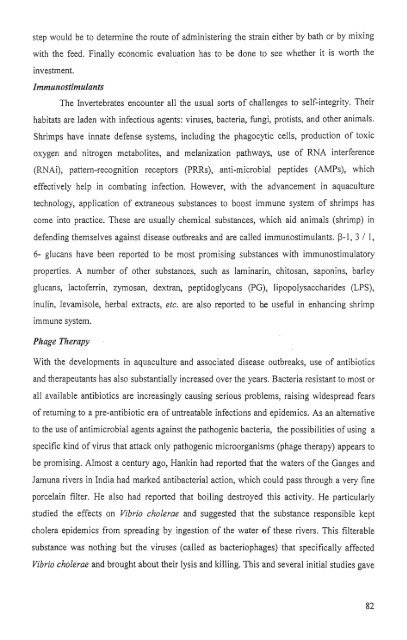, Diagnosis an-&& of Shrimp Diseases - Central Institute of ...
, Diagnosis an-&& of Shrimp Diseases - Central Institute of ...
, Diagnosis an-&& of Shrimp Diseases - Central Institute of ...
- No tags were found...
Create successful ePaper yourself
Turn your PDF publications into a flip-book with our unique Google optimized e-Paper software.
step would be to determine the route <strong>of</strong> administering the strain either by bath or by 111ixillgwith the feed. Finally economic evaluation has to be done to see whether it is worth theinvestment.ImnzunostimulffntsThe Invertebrates encounter all the usual sorts <strong>of</strong> challenges to self-integrity. Theirhabitats are laden with infectious agents: viruses, bacteria, fungi, protists, <strong>an</strong>d other <strong>an</strong>imals.<strong>Shrimp</strong>s have innate defense systems, including the phagocytic cells, production <strong>of</strong> toxicoxygen <strong>an</strong>d nitrogen metabolites, <strong>an</strong>d mel<strong>an</strong>ization pathways, use <strong>of</strong> RNA interference(RNAi), pattern-recognition receptors (PRRs), <strong>an</strong>ti-microbial peptides (AMPS), whicheffectively help in combating infection. However, with the adv<strong>an</strong>cement in aquacultilretechnology, application <strong>of</strong> extr<strong>an</strong>eous subst<strong>an</strong>ces to boost immune system <strong>of</strong> shrimps hascome into practice. These are usually chemical subst<strong>an</strong>ces, which aid <strong>an</strong>imals (shrimp) indefending themselves against disease outbreaks <strong>an</strong>d are called immunostimul<strong>an</strong>ts. P-1, 3 1 1,6- gluc<strong>an</strong>s have been reported to be most promising subst<strong>an</strong>ces with i~n~nunosti~nulatoryproperlies. A number <strong>of</strong> other subst<strong>an</strong>ces, such as laminarin, chitos<strong>an</strong>, saponins, barleygluc<strong>an</strong>s, lact<strong>of</strong>errin, zymos<strong>an</strong>, dextr<strong>an</strong>, peptidoglyc<strong>an</strong>s (PG), lipopolysaccharides (LPS),inulin, levamisole, herbal extracts, etc. are also reported to he useful in enh<strong>an</strong>cing shrimpimmune system.Plz age Tlz empyWith the developn~ents in aquaculture <strong>an</strong>d associated disease outbreaks, use <strong>of</strong> <strong>an</strong>tibiotics<strong>an</strong>d therapeut<strong>an</strong>ts has also subst<strong>an</strong>tially increased over the years. Bacteria resist<strong>an</strong>t to most orall available <strong>an</strong>tibiotics are increasingly causing serious problems, raising widespread fears<strong>of</strong> returning to a pre-<strong>an</strong>tibiotic era <strong>of</strong> untreatable infections <strong>an</strong>d epidemics. As <strong>an</strong> alternativeto the use <strong>of</strong> <strong>an</strong>timicrobial agents against the pathogenic bacteria, the possibilities <strong>of</strong> using aspecific kind <strong>of</strong> virus that attack only pathogenic microorg<strong>an</strong>isms (phage therapy) appears tobe promising. Almost a century ago, H<strong>an</strong>kin had reported that the waters <strong>of</strong> the G<strong>an</strong>ges <strong>an</strong>dJamuna rivers in India had marked <strong>an</strong>tibacterial action, which could pass through a very fineporcelain filter. He also had reported that boiling destroyed this activity. He partic~~larlystudied the effects 011Vibrio cholerae <strong>an</strong>d suggested that the s~tbst<strong>an</strong>ce responsible keptcholera epidemics from spreading by ingestion <strong>of</strong> the water <strong>of</strong> these rivers. This filterablesitbst<strong>an</strong>ce was nothing but the viruses (called as bacteriopl~ages) that specifically affectedYibrio cholerae <strong>an</strong>d brought about their lysis <strong>an</strong>d killing. This <strong>an</strong>d several initial studies gave
















